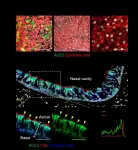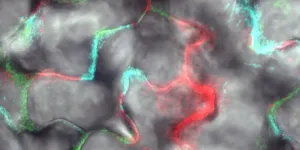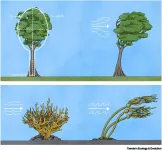Authigenic berthierine and incipient chloritization in shallowly buried sandstone reservoirs: Key role of the source-to-sink context
Maxime Virolle; Benjamin Brigaud; Daniel Beaufort; Patricia Patrier; Eid Abdelrahman ...
Abstract: Chlorite is recognized worldwide as a key mineral that inhibits the development of quartz cement in deeply buried sandstone reservoirs. Iron-rich chlorite is mainly formed by the transformation of a precursor clay mineral; however, few studies have focused on the early stages before the crystallization of chlorite. This study analyzed shallowly buried (400−1000 m) coastal sandstones from within the Wealden Group of the Paris Basin. Berthierine, a 7 Å trioctahedral clay mineral belonging to the serpentine group, approximatively with same chemistry as chlorite but a different crystal structure, has been identified in a 900-m-deep well but not in a 400−600-m-deep well. Berthierine has mainly been observed as clay coatings around detrital grains with a typical honeycomb texture. Nanopetrographic observations suggest that the honeycomb textural organization of the clay particles found in deeper buried sandstone reservoirs (>1500 m) is acquired from a berthierine precursor at shallow depths. However, small amounts of quartz overgrowths are observed on the surface of detrital grains at shallow depths and low temperature (below 40 °C), and it is believed that precursor berthierine coatings are primarily responsible for the inhibition of quartz overgrowths before Fe-rich chlorite is formed. This suggests that the key mineral primarily controlling the reservoir quality of deeply buried sandstone reservoirs is berthierine rather than iron-rich chlorite, which challenges the commonly accepted assertion that chlorite coating is the main process that inhibits quartz overgrowths. The source-to-sink context of the Paris Basin during the Early Cretaceous was decisive with respect to the supply of sands and berthierine clay precursors (in particular kaolinite and iron-rich, hydroxy-interlayered clay minerals) to the center of the basin.
View article: https://pubs.geoscienceworld.org/gsa/gsabulletin/article-abstract/doi/10.1130/B35865.1/605739/Authigenic-berthierine-and-incipient
Subduction initiation-induced rapid emplacement of garnet-bearing peridotites at a nascent forearc: Petrological and Os-Li isotopic evidence from the Purang ophiolite, Tibet
Xiao-Han Gong; Ji-Feng Xu; Ren-Deng Shi; Ben-Xun Su; Qi-Shuai Huang ...
Abstract: Garnet-bearing peridotites commonly occur in the deeper parts of mature or thickened oceanic lithosphere, and are rarely exhumed and emplaced onto the seafloor. The Purang ophiolitic peridotites in south Tibet contain rare symplectite pseudomorphs after garnet, offering a unique window into the still poorly understood evolution of the deep oceanic lithosphere. Here, integrated petrologic and Os-Li isotopic data are used to constrain the evolution and dynamics of emplacement for these garnet peridotite protoliths. The Purang peridotites show wide variations of chemical compositions (spinel Cr#: 0.2−0.8) and Os model ages (up to 2.0 Ga), thus representing a piece of heterogeneous oceanic mantle lithosphere. Dunite channels show two distinctive groups of Cr# of spinels and Os-isotope compositions, with the low- to medium-Cr# (0.2−0.6) and high-Cr# (0.7−0.8) dunites reflecting the reaction of host lherzolites/harzburgites with percolating mid-ocean ridge basalt−like and boninitic melts, respectively. This confirms recent subduction initiation-related melt percolation in the Purang peridotites. Coexisting olivines and pyroxenes in the peridotites show systematic Li elemental and isotopic disequilibrium, suggesting fast cooling of the peridotites to Li closure temperature shortly after the melt percolations, likely during exhumation of the peridotites onto the seafloor. This supports a close link between subduction initiation and tectonic emplacement of the Purang peridotites. Combined with other geological evidence, we suggest the Purang peridotites may originate from the deep part of old, thick oceanic lithosphere of the Neo-Tethys. This thick oceanic lithosphere was progressively weakened and thinned likely during widespread plume-lithosphere interaction, triggering the transformation of garnet peridotite protoliths to spinel peridotites. Subsequently, initiation of a new subduction zone along the lithospheric weakness caused rapid ascent and emplacement of the Purang peridotites at a nascent forearc.
View article: https://pubs.geoscienceworld.org/gsa/gsabulletin/article-abstract/doi/10.1130/B35960.1/604591/Subduction-initiation-induced-rapid-emplacement-of
A tale of two Tweefonteins: What physical correlation, geochronology, magnetic polarity stratigraphy, and palynology reveal about the end-Permian terrestrial extinction paradigm in South Africa
Robert A. Gastaldo; Johann Neveling; John W. Geissman; Sandra L. Kamo; Cindy V. Looy
Abstract: The contact between the Daptocephalus to Lystrosaurus declivis (previously Lystrosaurus) Assemblage Zones (AZs) described from continental deposits of the Karoo Basin was commonly interpreted to represent an extinction crisis associated with the end-Permian mass-extinction event at ca. 251.901 ± 0.024 Ma. This terrestrial extinction model is based on several sections in the Eastern Cape and Free State Provinces of South Africa. Here, new stratigraphic and paleontologic data are presented for the Eastern Cape Province, in geochronologic and magnetostratigraphic context, wherein lithologic and biologic changes are assessed over a physically correlated stratigraphy exceeding 4.5 km in distance. Spatial variation in lithofacies demonstrates the gradational nature of lithostratigraphic boundaries and depositional trends. This pattern is mimicked by the distribution of vertebrates assigned to the Daptocephalus and L. declivis AZs where diagnostic taxa of each co-occur as lateral equivalents in landscapes dominated by a Glossopteris flora. High-precision U-Pb zircon (chemical abrasion-isotope dilution-thermal ionization mass spectrometry) age results indicate maximum Changhsingian depositional dates that can be used as approximate tie points in our stratigraphic framework, which is supported by a magnetic polarity stratigraphy. The coeval nature of diagnostic pre- and post-extinction vertebrate taxa demonstrates that the L. declivis AZ did not replace the Daptocephalus AZ stratigraphically, that a biotic crisis and turnover likely is absent, and a reevaluation is required for the utilization of these biozones here and globally. Based on our data set, we propose a multidisciplinary approach to correlate the classic Upper Permian localities of the Eastern Cape Province with the Free State Province localities, which demonstrates their time-transgressive nature.
View article: https://pubs.geoscienceworld.org/gsa/gsabulletin/article-abstract/doi/10.1130/B35830.1/604557/A-tale-of-two-Tweefonteins-What-physical
Paleomagnetic dating of prehistoric lava flows from the urban district of Catania (Etna volcano, Italy)
Andrea Magli; Stefano Branca; Fabio Speranza; Gilda Risica; Gaia Siravo ...
Abstract: Determining the ages of past eruptions of active volcanoes whose slopes were historically inhabited is vitally important for investigating the relationships between eruptive phenomena and human settlements. During its almost three-millennia-long history, Catania--the biggest city lying at the toe of Etna volcano--was directly impacted only once by the huge lava flow emplaced during the A.D. 1669 Etna flank eruption. However, other lava flows reached the present-day Catania urban district in prehistoric ages before the founding of the city in Greek times (729/728 B.C., i.e., 2679/2678 yr B.P.). In this work, the Holocene lava flows of Barriera del Bosco, Larmisi, and San Giovanni Galermo, which are exposed in the Catania urban district, were paleomagnetically investigated at 12 sites (120 oriented cores). Paleomagnetic dating was obtained by comparing flow-mean paleomagnetic directions to updated geomagnetic reference models for the Holocene. The Barriera del Bosco flow turns out to represent the oldest eruptive event and is paleomagnetically dated to the 11,234−10,941 yr B.P. and 8395−8236 yr B.P. age intervals. The mean paleomagnetic directions from the San Giovanni Galermo and Larmisi flows overlap when statistical uncertainties are considered. This datum, along with geologic, geochemical, and petrologic evidence, implies that the two lava flows can be considered as parts of a single lava field that erupted in a narrow time window between 5494 yr B.P. and 5387 yr B.P. The emplacement of such a huge lava flow field may have buried several Neolithic settlements, which would thus explain the scarce occurrence of archaeological sites of that age found below the town of Catania.
View article: https://pubs.geoscienceworld.org/gsa/gsabulletin/article-abstract/doi/10.1130/B36026.1/602750/Paleomagnetic-dating-of-prehistoric-lava-flows
Migmatite and leucogranite in a continental-scale exhumed strike-slip shear zone: Implications for tectonic evolution and initiation of shearing
Junyu Li; Shuyun Cao; Xuemei Cheng; Franz Neubauer; Haobo Wang ...
Abstract: Plutons within continental strike-slip shear zones bear important geological processes on late-stage plate transpression and continent-continent collision and associated lateral block extrusion. Where, when, and how intrusions and shearing along transpressional strike-slip shear zones respond to plate interactions, however, are often debated. In this study, we investigated migmatite associated leucogranite and pegmatite from the exhumed >1000-km-long Ailao Shan-Red River left-lateral strike-slip shear zone in Southeast Asia that was active during India-Eurasia plate convergence. Most zircons from the migmatites and leucogranitic intrusions present inherited core-rim structure. The depletion of rare earth element patterns and positive Eu anomalies suggest that leucosomes and leucogranites are the result of crustal anatexis. Zircon rims from the foliated migmatites and leucogranites record U-Pb ages of 41−28 Ma, revealing the timing of the Cenozoic crustal anatexis event along this strike-slip shear zone. Ages of the magmatic zircons from the unfoliated pegmatites provide the timing of the termination of a high-temperature tectono-thermal event and ductile left-lateral shearing at 26−23 Ma. The Cenozoic crustal anatexis along the Ailao Shan-Red River strike-slip shear zone indicates that thickened crust underneath the shear zone involved previously subducted crust. We propose that the Cenozoic thermal state has an important effect on the crustal anatexis and thus on the rheological behavior of the lithosphere by thermal weakening, which plays an essential role in localizing the initiation of the deep-seated lower-crustal shear zone.
View article: https://pubs.geoscienceworld.org/gsa/gsabulletin/article-abstract/doi/10.1130/B35988.1/602751/Migmatite-and-leucogranite-in-a-continental-scale
The impact of a tear in the subducted Indian plate on the Miocene geology of the Himalayan-Tibetan orogen
Rui Wang; Roberto F. Weinberg; Di-Cheng Zhu; Zeng-Qian Hou; Zhi-Ming Yang
Abstract: The Yadong-Gulu Rift, cutting across the Gangdese belt and Himalayan terranes, is currently associated with a thermal anomaly in the mantle and crustal melting at 15−20 km depth. The rift follows the trace of a tear in the underthrusted Indian continental lithospheric slab recognized by high resolution geophysical methods. The Miocene evolution of a 400-km-wide band following the trace of the tear and the rift, records differences interpreted as indicative of a higher heat flow than its surroundings. In the Gangdese belt, this band is characterized by high-Sr/Y granitic magmatism that lasted 5 m.y. longer than elsewhere and by the highest values of εHf(i) and association with the largest porphyry Cu-Mo deposits in the Gangdese belt. Anomalously young magmatic rocks continue south along the rift in the Tethyan and Higher Himalayas. Here, a 300-km-wide belt includes some of the youngest Miocene Himalayan leucogranites; the only occurrence of mantle-derived mafic enclaves in a leucogranite; young mantle-derived lamprophyre dikes; and the youngest and hottest migmatites in the Higher Himalayas. These migmatites record a history of rapid exhumation contemporaneous with the exhumation of Miocene mafic eclogite blocks, which are unique to this region and which were both heated to >800 °C at ca. 15−13 Ma, followed by isothermal decompression. We suggest that the prominent tear in the Indian lithosphere, sub-parallel to the rift, is the most likely source for these tectono-thermal anomalies since the Miocene.
View article: https://pubs.geoscienceworld.org/gsa/gsabulletin/article-abstract/doi/10.1130/B36023.1/602752/The-impact-of-a-tear-in-the-subducted-Indian-plate
The timeline of prolonged accretionary processes in eastern Central Asian Orogenic Belt: Insights from episodic Paleozoic intrusions in central Inner Mongolia, North China
Lingling Yuan; Xiaohui Zhang; Zhili Yang
Abstract: Updating magmatic profile in crucial constituent terranes across the Central Asian Orogenic Belt presents a key to chronicling the timeline of prolonged accretionary processes and termination of the Paleo-Asian Ocean in the northern China−southern Mongolia tract. Here we performed a systematic geochronological and geochemical study on a spectrum of Paleozoic intrusions from the Erenhot region in central Inner Mongolia, North China, within the hinterland of the tract, with four distinct magmatic episodes unraveled. Combining these episodes with the previously documented events from contiguous regions defines two major tectono-magmatic cycles. The early Paleozoic cycle (500−450 Ma) evolved from initial fluid-fluxed tholeiitic and calc-alkaline granitoids to melt-fertilized mafic-intermediate magmatism. It appears to experience the initiation and maturation of a Western Pacific-type intra-oceanic arc system that culminated in ridge subduction. The late Paleozoic cycle expanded in magmatic expression from sporadic Late Devonian (373−365 Ma) calc-alkaline intermediate-felsic pulses through Early-Middle Carboniferous (356−320 Ma) medium to high-K calc-alkaline flare-up to a Late Carboniferous−Early Permian (310−277 Ma) province of diverse lithologies. These magmatic episodes seem to encompass a complete active continental arc−back-arc system that spanned from resuming oceanic plate subduction through slab rollback and backarc rifting to ridge-trench collision and backarc basin closure. Featuring a Rodinia-aged terrane affinity and a representative Paleozoic magmatic profile, the Erenhot region provides an optimal site for correlating the evolution of mosaic terranes in southern Mongolia and northern China, and for evaluating the coupled evolution of shifting tectonic regimes and plural crustal generation mechanisms within a retreating accretionary orogen.
View article: https://pubs.geoscienceworld.org/gsa/gsabulletin/article-abstract/doi/10.1130/B35907.1/602753/The-timeline-of-prolonged-accretionary-processes
Pure sediment-derived granites in a subduction zone
Jian Xu; Xiao-Ping Xia; Qiang Wang; Christopher J. Spencer; Chun-Kit Lai ...
Abstract: The Earth is unique in the Solar System due to significant volumes of granite in the lithosphere. However, the origins of granites are still highly debated, especially sediment-derived granites, which are often treated as a geochemical end-member of the continental crust. In the Yunnan region of South China, we identify the occurrence of pure sediment-derived granite in a subduction system. The suite of strongly peraluminous granite reported herein is interpreted to represent pure metasedimentary melts based on their whole-rock elemental and Sr-Nd-B and zircon Hf-O isotopic compositions. These Late Permian−Early Triassic (ca. 254−248 Ma) granites are characterized by radiogenically enriched Sr, Nd, and Hf isotopic signatures. They show δ11B and δ18O signatures akin to those of continental shales. Geochemical modeling indicates no contributions from the mantle that can be detected. Considering the regional tectonic evolution, these granites are suggested to be formed in a subduction zone by decompression melting of rapidly exhumed back-arc sediments. We posit that decompression melting was triggered by widespread extension and thinning of the crust prompted by rollback of the subducting oceanic crust. These granites thus provide evidence that granite formation in subduction zones does not necessarily contribute to crustal growth. These subduction-related pure sediment-derived granites have different elemental ratios and contents (e.g., Al2O3/TiO 2 and Yb) from the Himalayan leucogranites. Considering their source compositions (e.g., pelitic rocks), which are similar to those of the Himalayan leucogranites, these differences are likely due to their higher formation temperature and lower pressure despite a great similarity in isotopic compositions. Identification of pure sediment-derived, strongly peraluminous granites (SPGs) in subduction systems provides an important geodynamic mechanism for crustal anatexis, which can both geochemically and tectonically complement their collisional counterparts identified in the Himalayas.
View article: https://pubs.geoscienceworld.org/gsa/gsabulletin/article-abstract/doi/10.1130/B36016.1/602698/Pure-sediment-derived-granites-in-a-subduction
Mafic-ultramafic intrusion formed by multi-stage evolution of hydrous basaltic melts
Qi-Wei Li; Jun-Hong Zhao; Mei-Fu Zhou; Jian-Feng Gao
Abstract: The magmatic processes beneath the active continental margins are very complicated and affect structures and compositions of the arc roots. Neoproterozoic igneous rocks are widely distributed around the margins of the Tarim Block in NW China. The Xingdier mafic-ultramafic intrusion is a composite body, located at the northern margin of the Tarim Block, and consists of gabbro, pyroxenite, and peridotite units. The gabbro unit has a secondary ion mass spectrometry zircon U-Pb age of 727 ± 5 Ma. Rocks from the Xingdier intrusion have a large range of MgO (12.9−32.8 wt%) and SiO 2 (43.0−57.9 wt%), and low K2O+Na2O (0.11−2.25 wt%) contents. They have right inclined chondrite-normalized rare earth element patterns with (La/Yb)N ratios of 2.2−8.6. Their primitive mantle normalized trace element patterns show arc-affinity geochemical features characterized by enrichment in Rb, Ba, Th, U, and Pb and depletion in Nb, Ta, and Ti. They have variable initial 87 Sr/86Sr ratios (0.7063−0.7093), εNd(t) values (−2.9 to −7.8),206Pb/204Pb (17.08−17.80), 207Pb/ 204Pb (15.42−15.49), and 208Pb/204Pb ratios (37.48−38.05), forming an evolution trend from the peridotite unit to the gabbro and pyroxenite units. Clinopyroxene in the three units is chemically similar to those formed in hydrous magmas. The spinel inclusions in olivine from the peridotite unit show unmixing texture and have high Al contents and oxygen fugacity of ∼FMQ+1. Therefore, the parental magma was probably derived from a lithospheric mantle enriched by slab-derived fluids. Rocks from the gabbro and peridotite units are proposed to have been derived from olivine-normative melts, whereas rocks from the pyroxenite unit are cumulates from the quartz-normative melts. Such contrasting parental magmas resulted from variable degrees of crustal contamination and fractional crystallization in the arc root.
View article: https://pubs.geoscienceworld.org/gsa/gsabulletin/article-abstract/doi/10.1130/B35920.1/601081/Mafic-ultramafic-intrusion-formed-by-multi-stage
Origin of syn-collisional granitoids in the Gangdese orogen: Reworking of the juvenile arc crust and the ancient continental crust
Yu-Wei Tang; Long Chen; Zi-Fu Zhao; Yong-Fei Zheng
Abstract: Granitoids at convergent plate boundaries can be produced either by partial melting of crustal rocks (either continental or oceanic) or by fractional crystallization of mantle-derived mafic magmas. Whereas granitoid formation through partial melting of the continental crust results in reworking of the pre-existing continental crust, granitoid formation through either partial melting of the oceanic crust or fractional crystallization of the mafic magmas leads to growth of the continental crust. This category is primarily based on the radiogenic Nd isotope compositions of crustal rocks; positive εNd(t) values indicate juvenile crust whereas negative εNd(t) values indicate ancient crust. Positive εNd(t) values are common for syn-collisional granitoids in southern Tibet, which leads to the hypothesis that continental collision zones are important sites for the net growth of continental crust. This hypothesis is examined through an integrated study of in situ zircon U-Pb ages and Hf isotopes, whole-rock major trace elements, and Sr-Nd-Hf isotopes as well as mineral O isotopes for felsic igneous rocks of Eocene ages from the Gangdese orogen in southern Tibet. The results show that these rocks can be divided into two groups according to their emplacement ages and geochemical features. The first group is less granitic with lower SiO2 contents of 59.82−64.41 wt%, and it was emplaced at 50−48 Ma in the early Eocene. The second group is more granitic with higher SiO2 contents of 63.93−68.81 wt%, and it was emplaced at 42 Ma in the late Eocene. The early Eocene granitoids exhibit relatively depleted whole-rock Sr-Nd-Hf isotope compositions with low (87Sr/86Sr)i ratios of 0.7044−0.7048, positive εNd(t) values of 0.6−3.9, ε Hf(t) values of 6.5−10.5, zircon εHf(t) values of 1.6−12.1, and zircon δ18O values of 5.28−6.26‰. These isotopic characteristics are quite similar to those of Late Cretaceous mafic arc igneous rocks in the Gangdese orogen, which indicates their derivation from partial melting of the juvenile mafic arc crust. In comparison, the late Eocene granitoids have relatively lower MgO, Fe2O3, Al2O3, and heavy rare earth element (HREE) contents but higher K2O, Rb, Sr, Th, U, Pb contents, Sr/Y, and (La/Yb) N ratios. They also exhibit more enriched whole-rock Sr-Nd-Hf isotope compositions with high (87Sr/86Sr) i ratios of 0.7070−0.7085, negative εNd(t) values of −5.2 to −3.9 and neutral εHf(t) values of 0.9−2.3, and relatively lower zircon εHf(t) values of −2.8−8.0 and slightly higher zircon δ18O values of 6.25−6.68‰. An integrated interpretation of these geochemical features is that both the juvenile arc crust and the ancient continental crust partially melted to produce the late Eocene granitoids. In this regard, the compositional evolution of syn-collisional granitoids from the early to late Eocene indicates a temporal change of their magma sources from the complete juvenile arc crust to a mixture of the juvenile and ancient crust. In either case, the syn-collisional granitoids in the Gangdese orogen are the reworking products of the pre-existing continental crust. Therefore, they do not contribute to crustal growth in the continental collision zone.
View article: https://pubs.geoscienceworld.org/gsa/gsabulletin/article-abstract/doi/10.1130/B35928.1/601082/Origin-of-syn-collisional-granitoids-in-the
Mantle source of tephritic porphyry in the Tarim Large Igneous Province constrained from Mg, Zn, Sr, and Nd isotope systematics: Implications for deep carbon cycling
Weiliang Kong; Zhaochong Zhang; Zhiguo Cheng; Bingxiang Liu; M. Santosh ...
Abstract: The nature and source of magmatism associated with large igneous provinces (LIPs) remain disputed. Here we investigate the role of recycled materials that contributed to mantle heterogeneity in the Tarim Large Igneous Province (TLIP) in China through integrated Zn−Mg−Sr−Nd isotopes of a rare tephritic rock suite. The Sr−Nd isotopes [(87Sr/86Sr)i = 0.70368−0.70629; εNd(t) = −0.25−4.64] and δ 26Mg values (−0.23‰ to −0.34‰) of the tephritic porphyries are consistent with a normal mantle origin. In contrast, the whole rock and pyroxene phenocrysts yield δ66Zn values of +0.28‰ to +0.46‰ and +0.30‰ to +0.39‰, which are slightly heavier than those of the terrestrial mantle (+0.16 ± 0.06‰) and mid-oceanic-ridge basalts (MORBs) (+0.27 ± 0.05‰). We exclude the possibility that the heavy Zn isotopes of the Wajilitag tephritic porphyries are caused by magmatic processes such as fractional crystallization and partial melting and correlate the isotopic features to the role of altered oceanic crust along with magnesite in the mantle source. The Wajilitag tephritic porphyry displays trace-element patterns similar to those of the melts from natural hornblendite, especially those of hornblendite + peridotite. Additionally, the geochemical characteristics such as enrichment in Nb and Ta, depletion in K, high TiO2, and constant Na2O/K2O ratios also suggest that the tephritic porphyries were derived from an amphibole-bearing source contributed by altered oceanic crust along with sedimentary carbonates. Our study provides insight into the contribution of subducted materials to the mantle heterogeneity beneath the TLIP and highlights the role of subduction in the deep carbon cycle and subducted slab-lithosphere-plume interaction in the generation of LIPs.
View article: https://pubs.geoscienceworld.org/gsa/gsabulletin/article-abstract/doi/10.1130/B35902.1/600886/Mantle-source-of-tephritic-porphyry-in-the-Tarim
Sedimentology, geochronology, and provenance of the late Cenozoic "Yangtze Gravel": Implications for Lower Yangtze River reorganization and tectonic evolution in southeast China
Ping Wang; Hongbo Zheng; Yongdong Wang; Xiaochun Wei; Lingyu Tang ...
Abstract: The evolution of the Yangtze River, the longest river in Asia, provides a spectacular example for understanding the Cenozoic interaction between tectonics, climate, and surficial processes. The oldest Lower Yangtze deposits, characterized by ∼100-m-thick sequences of unconsolidated conglomerate, sandstone, and siltstone, referred to as "Yangtze Gravel," have been recently dated >23 Ma, indicating a pre-Miocene establishment of a through-going river. However, the link between river integration and tectonic evolution has never been established due to the limited study of these sediments. Here, we report sedimentology, geochronology, and provenance of the Yangtze Gravel based on 17 stratigraphic sections exposed along the Lower Yangtze River. Our new chronostratigraphic results, including 40Ar/39Ar ages from the overlying basalt and fossil-based stratigraphic correlation, suggest an early-middle Miocene age for these sediments. Detailed analysis of lithofacies reveals several sequences of coarse-grained channel-belt deposits (channel fills and bars), indicating braided alluvial deposition across the Jianghan Basin, North Jiangsu-South Yellow Sea Basin, and East China Sea Shelf Basin. This ancient Lower Yangtze River is further characterized by petrography and detrital zircon U-Pb geochronology results which show similar provenance and erosion pattern as the present-day Yangtze River. However, the ancient river in early-middle Miocene is an alluvial, bedload-dominated braided river with higher stream power and a more prolonged course flowing into the East China Sea Shelf Basin. These differences between ancient and modern Lower Yangtze River reflect varied climate and paleogeography in southeast China during the late Cenozoic. Compared with the Paleogene red-colored, halite-bearing, Ephedripite pollen-dominated, lacustrine deposits in Jianghan Basin and North Jiangsu-South Yellow Sea Basin, the deposition of yellow to green-colored, coarse-grained, arboreal pollen, and wood-dominated Yangtze Gravel indicates a drainage reorganization from hydrologically closed lakes to a through-going river system during late Oligocene to early Miocene. During Paleogene, rift basins were filled by alluvial and fluvial-lacustrine deposition with restricted flow distance and local sources. From late Oligocene to early-middle Miocene, the post-rift subsidence opens a path for the ancient Lower Yangtze River connecting the Jianghan Basin, North Jiangsu-South Yellow Sea Basin, and East China Sea Shelf Basin. We attribute the drainage reorganization of the Lower Yangtze River to be a surficial response to Cenozoic tectonics, particularly the western Pacific subduction, in southeast China. The deposition of the widespread, coarse-grained Yangtze Gravel is probably due to the combined effects of catchment expansion and strong monsoonal climate in East Asia.
View article: https://pubs.geoscienceworld.org/gsa/gsabulletin/article-abstract/doi/10.1130/B35851.1/600887/Sedimentology-geochronology-and-provenance-of-the
Thermotectonic events recorded by U-Pb geochronology and Zr-in-rutile thermometry of Ti oxides in basement rocks along the P2 fault, eastern Athabasca Basin, Saskatchewan, Canada
E. Adlakha; K. Hattori
Abstract: Basement rocks below the Athabasca Basin, Saskatchewan, have been intensely altered through paleoweathering and multiple hydrothermal events, including the formation of world-class unconformity-type uranium deposits. Here, we demonstrate the utility of Ti-oxide thermochronology for identifying thermotectonic events in these altered rocks leading to uranium mineralization along basement structures. Rutile grains along the P2 fault, a major fault in the eastern Athabasca Basin, exhibit 207Pb/ 206Pb ages of ca. 1850−1700 Ma, with a weighted mean of 1757 ± 6 Ma (mean square of weighted deviation [MSWD] = 1.4, n = 116). The older ages (~1770 Ma) record regional metamorphism reaching a temperature of 875 °C during the Trans-Hudson orogeny. Pb diffusion modeling indicates that metamorphic rutile should exhibit cooling ages of 1760−1750 Ma. Rutile grains showing young ages, ~1750 Ma, reflect isotopic resetting during regional asthenospheric upwelling between 1770 and 1730 Ma related to the emplacement of the Kivalliq igneous suite to the north. This thermotectonic event (temperature ~550 °C) promoted hydrothermal activity to produce silicified rocks, i.e., "quartzite," along the P2 fault, which later focused mineralizing fluids for unconformity-type uranium deposits. The young rutile ages also indicate that the basement rocks remained hot until 1700 Ma, providing the maximum age for the deposition of the Athabasca sediments. Anatase yields a concordia age of 1569 ± 31 Ma (MSWD = 0.30, n = 5), which is within uncertainty of the oldest ages for uraninite of the McArthur River deposit. This age corresponds to the incursion of basinal fluids in the basement along the P2 fault during uranium mineralization.
View article: https://pubs.geoscienceworld.org/gsa/gsabulletin/article-abstract/doi/10.1130/B35820.1/600747/Thermotectonic-events-recorded-by-U-Pb
Superposition of Cretaceous and Cenozoic deformation in northern Tibet: A far-field response to the tectonic evolution of the Tethyan orogenic system
Ye Wang; Xuanhua Chen; Yaoyao Zhang; Zheng Yin; Andrew V. Zuza ...
Abstract: Although the Cenozoic Indo-Asian collision is largely responsible for the formation of the Tibetan plateau, the role of pre-Cenozoic structures in controlling the timing and development of Cenozoic deformation remains poorly understood. In this study we address this problem by conducting an integrated investigation in the northern foreland of the Tibetan plateau, north of the Qilian Shan-Nan Shan thrust belt, NW China. The work involves field mapping, U-Pb detrital-zircon dating of Cretaceous strata in the northern foreland of the Tibetan plateau, examination of growth-strata relationships, and construction and restoration of balanced cross sections. Our field mapping reveals multiple phases of deformation in the area since the Early Cretaceous, which was expressed by northwest-trending folding and northwest-striking thrusting that occurred in the early stages of the Early Cretaceous. The compressional event was followed immediately by extension and kinematically linked right-slip faulting in the later stage of the Early Cretaceous. The area underwent gentle northwest-trending folding since the late Miocene. We estimate the magnitude of the Early Cretaceous crustal shortening to be ∼35%, which we interpret to have resulted from a far-field response to the collision between the Lhasa and the Qiangtang terranes in the south. We suggest that the subsequent extension in the Early Cretaceous was induced by orogenic collapse. U-Pb dating of detrital zircons, sourced from Lower Cretaceous sedimentary clasts from the north and the south, implies that the current foreland region of the Tibetan plateau was a topographic depression between two highland regions in the Early Cretaceous. Our work also shows that the Miocene strata in the foreland region of the northern Tibetan plateau was dominantly sourced from the north, which implies that the rise of the Qilian Shan did not impact the sediment dispersal in the current foreland region of the Tibetan plateau where this study was conducted.
View article: https://pubs.geoscienceworld.org/gsa/gsabulletin/article-abstract/doi/10.1130/B35944.1/600737/Superposition-of-Cretaceous-and-Cenozoic
INFORMATION:
GSA BULLETIN articles published ahead of print are online at
https://bulletin.geoscienceworld.org/content/early/recent
. Representatives of the media may obtain complimentary copies of articles
by contacting Kea Giles. Please discuss articles of interest with the
authors before publishing stories on their work, and please make reference
to The Geological Society of America Bulletin in articles published.
Non-media requests for articles may be directed to GSA Sales and Service,
gsaservice@geosociety.org.
https://www.geosociety.org




